NEW WAVE: ROLL OUT THE BARRELS
WORDS: DAVE SWAN – Smorgasboarder Magazine
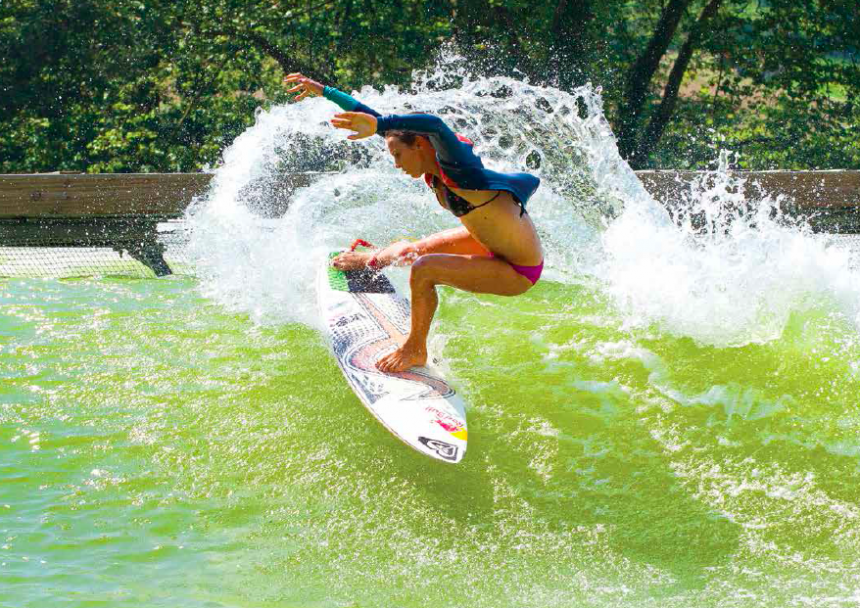
With the recent announcement of a proposed wave park in our own neck of the woods on the Sunshine Coast, we were intrigued to know more about this development, and indeed the diverse world of artificial wave making. We were equally astounded by the level of development in this field and indeed our own naivety to this industry, and an industry it well and truly is.
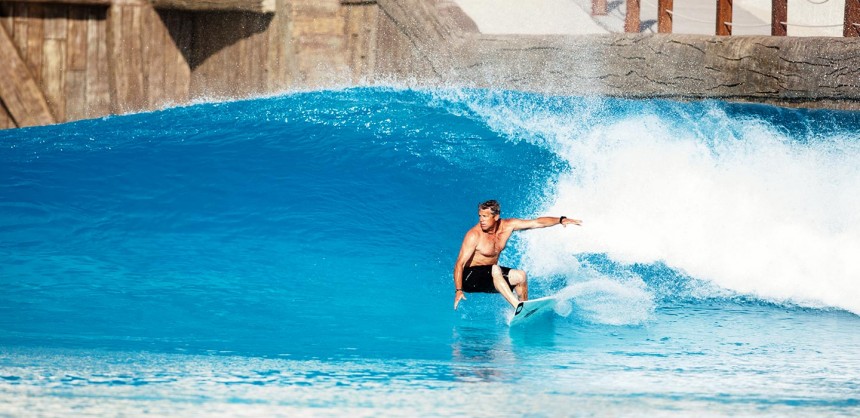
Wave pools are most certainly controversial. They have generated a great deal of interest and incited heated debate. They are somewhat of a dividing force in the surfing world as we know it. So is it worthy of our examination? Without doubt. How does one form an opinion or indeed strengthen their views without first acquiring as much information as possible about the subject at large.
Without doubt, wave pools are an interesting topic of discussion. Never ones to shy away from controversial topics, we decided to investigate what is happening in the literal “world” of wave pools and the various pros and cons of man-made waves. So sit back and read what we have found out and what we understand to be happening in this space. Then either get yourself drooling over the prospect of near-perfect waves or hot under the collar about the soul of surfing being sold to the demons of commerce… Whatever takes your fancy, we hope to stoke your fire.
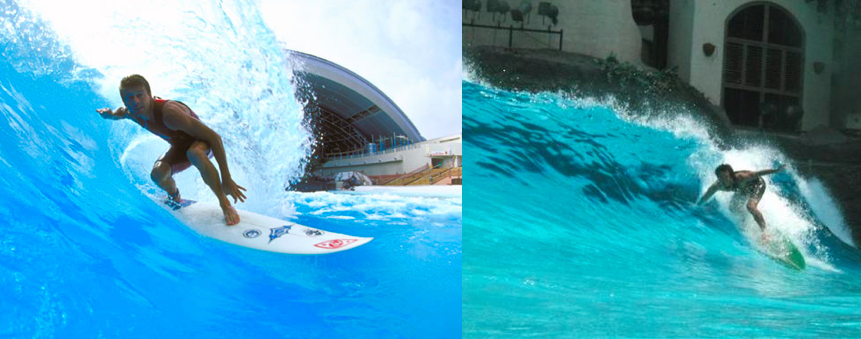
Seagaia Ocean Dome in Miyazaki, Japan — Officially closed in October 2007
From a personal perspective I must admit, the more I delved into this subject, the more it proved to be incredibly fascinating. I’d never have imagined there was such an extensive history to artificial wave making, let alone various types of technological approaches to creating waves. I only knew of a wave machine at Dreamworld on the Gold Coast, Seagaia over in Japan under a giant dome, and the waves rolling down the Wavegarden in Spain I recently watched in awe. Quite clearly, my fast-paced lifestyle on the Sunshine Coast had left me oblivious to the goings-on around the world. I guess the first place to start is to provide those who aren’t in the know with a brief rundown on the history of wave machines and the kinds of waves they create…
Our research suggests it was the late, great, crazy King Ludwig II of Bavaria who was the first to simulate the waves created by Mother Nature. Famous for his favour of extravagant artistic and architectural projects, such as the world-renowned Neuschwanstein Castle, King Ludwig electrified a lake to create breaking waves. Although some thought this a shocking idea, we guess he thought it would be electrifyingly cool. Funnily enough, King Ludwig in years to come was declared insane by his ministers and committed for pouring all of his royal revenues into such ventures. Wave pool critics would argue we will soon see history repeating itself. Today however, King Ludwig is revered by Bavarians for the many important tourist attractions he built during his reign. The next to make waves (pardon the pun) were the Hungarians in 1927, followed by the Brits in 1939. Their creation, a 60m x 20m pool featuring electric pistons that drove massive paddles, made lapping waves that were bigger than Ludwig’s ripples, but still they weren’t much chop, or indeed they were just chop.
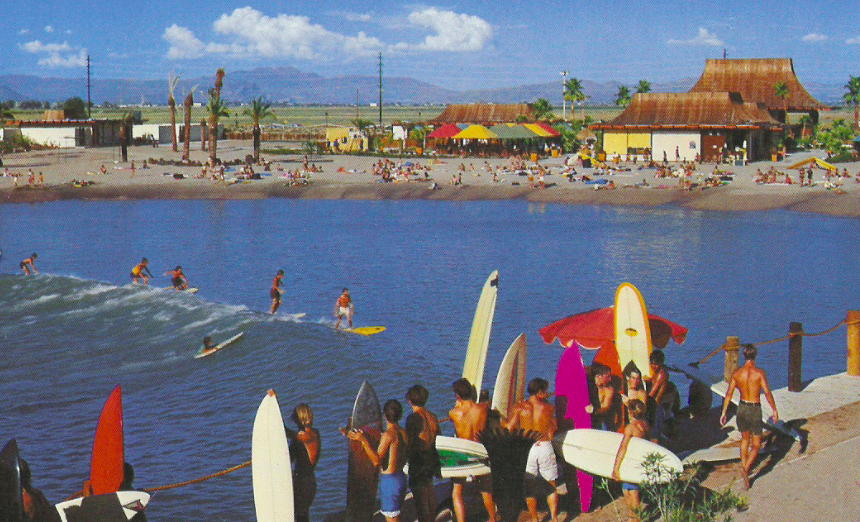
Big Surf’s wave pool, Waikiki Beach, is the original North American wave pool. Photo: Big Surf, AZ
The first artificial waves to be ridden by surfers was in 1966. Tokyo’s Summerland amusement park built a “Surfa-Torium” using similar technology to the Brits some three decades earlier. The techno-savvy Japanese managed to create liquid lumps that could be ridden with a soft board, but they were pretty gutless. In 1969, the yanks had a crack, on a grand scale. A huge 120m x 90m wave pool set amongst 20 acres of Hawaiian themed landscaping was constructed – in Arizona of all places, some 600kms from the nearest beach. Big Surf was a valiant effort and a step in the right direction but still a far cry from anything the ocean could deliver. They were at it again in 1985 when Wildwater Kingdom in Allentown, Pennsylvania held the first World Professional Inland Surfing Championship, but only Tommy Carroll at the height of his powers could achieve anything of note on the wave, which saw him win the title. The 2ft wave was a popular addition to the Dorney Amusement Park but was just that – an amusement park ride rather than a rippable wave of substance. What was evident however, from Germany to Hungary to England, Japan and The United States, was that the worldwide race for man-made waves had already well and truly begun. Over the next decade things stepped up a notch and the method of creating artificial waves was pursued through varying technologies.
Ocean Waves
These wonders of nature are the ones we all enjoy and are formed by such factors as the wind, tide and the typography of the ocean floor. Through time humans have endeavored to replicate ocean waves by moving turbine blades, paddles and all manner of moveable objects through water at speed to displace fluid creating a crest and an accompanying trough, just like when you slide in a bath tub. Another method is to push large volumes of water through a gate. When the water hits the artificial reef of the wave pool floor it forms a wave similar to those found in the ocean.
Sheet Waves
These are created when water flows over a surface at high speed and is diverted upwards. Part of the flow rises upwards above the rest of the water creating a standing wave. In nature these can be found in places such as the famous Eisbach River in Munich. Indeed the Bavarian capital is the birthplace of river surfing. Surfers have been riding this “stationary wave” since the early ’70s. I say stationary because whilst the surfer has a sense of being propelled forward on the wave, they in fact remain stationary. Humans have been able to affectively recreate these “hydraulic jumps” with create success, which we will touch on shortly. River surfing stationary “sheet waves” are not to be confused however with tidal bores (bore is just another name for wave or swell). Whilst bores are a different manifestation of a “hydraulic jump” a surfer is actually propelled along the “bore”. These kinds of waves are generated by way of large volumes of water traveling at speed from a wide bay upriver against the current of a narrow river. Indonesia’s “Bono” tidal bore, popularly known amongst surfers as the “Seven Ghosts” is one such example.
Wadi Adventure
Situated in Al Ain, Wadi is the Middle East’s first man-made whitewater rafting, kayaking and surfing facility. If you thought it was incredible that there was a surfable wave out in the middle of the desert, your jaw will hit the floor when you see what they’ve done to accommodate all water sports. Firstly there’s the world’s largest surf pool which holds about 13 million litres of water at a controlled, balmy 28°C all year round.
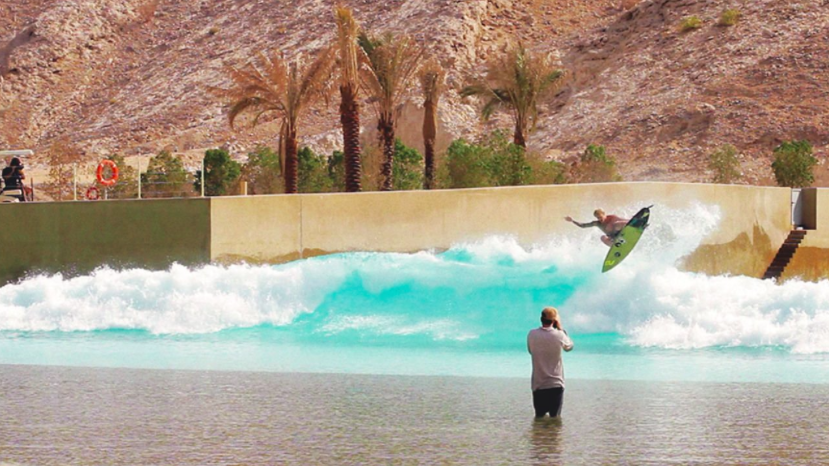
Chippa Wilson at Wadi Adventure Wave Pool in Al Ain, UAE. Photo: Matthew O’Brien
Get in and surfing from about $30, or you can book a 55 minute private session from around $175 to $400, depending on how exclusive you want it.. Then there’s 1.2km of whitewater channels, a cable wake boarding park and if you need to get out of the water, there’s an aerial obstacle course, including a two-storey airpark.
More info online at www.wadiadventure.ae
Competing Technologies
At this point in time, we thought we would go into a little more detail about the main players behind these competing technologies to understand their place in the wave-machine race and how their approach differs.
Wave Loch
Tom Lochetfeld formed Wave Loch and in 1991 unveiled his proprietary sheet wave technology to the public. It was called the FlowRider and used submersible pumps to create a non-stop, curling wave over a soft-padded surface. Wave Loch’s FlowBarrel, then became the world’s first artificial barreling wave using similar technology in 2001.
The popularity of this man-made wave is undeniable. Wave Loch has over 175 sheet wave installations worldwide in water parks and swim centres to theme parks, resorts, private homes of the extremely wealthy and even a cruise ship – see above, the Flowrider aboard the Royal Caribbean cruiseliner Freedom of the Seas. Here in Australia they can be found at Dreamworld and Wet N’ Wild on the Gold Coast, The Melbourne Aquatic Centre and Goldfields Oasis Aquatic Centre in Western Australia. In New Zealand, they can be found… Nowhere. You have enough of the natural variety. But whilst the Wave Loch sheet wave has attracted surfers and non-surfers alike en mass, the downside is it’s not like surfing a wave in the ocean. Riders in effect balance on a finless surfboard and maneuver themselves up and down the wave but not along it. It’s a board sport for sure, but surfing as we know it? That’s questionable, but then again, who cares if it’s a lot of fun. To surfers, skurfers, wakeboarders, skateboarders and snowboarders, it is another outlet to express themselves and show their talent.
American Wave Machines
Founded in 2000 by Californian surfer Bruce McFarland, American Wave Machines patented their own version of a stationary sheet wave they called SurfStream – an endless standing wave made by continuously pumping water in a recirculating pool and channel system. From what we understand, the main difference with this technology to that of Wave Loch’s FlowRider is that riders can use surfboards with fins as the water is deeper and the SurfStream can create different types of waves from spilling to barreling by alternating the speed and depth of the water. Different scale SurfStream wave machines have been installed in New Hampshire, Peru, Sweden and the Caribbean with others under construction in Montreal and Chicago.
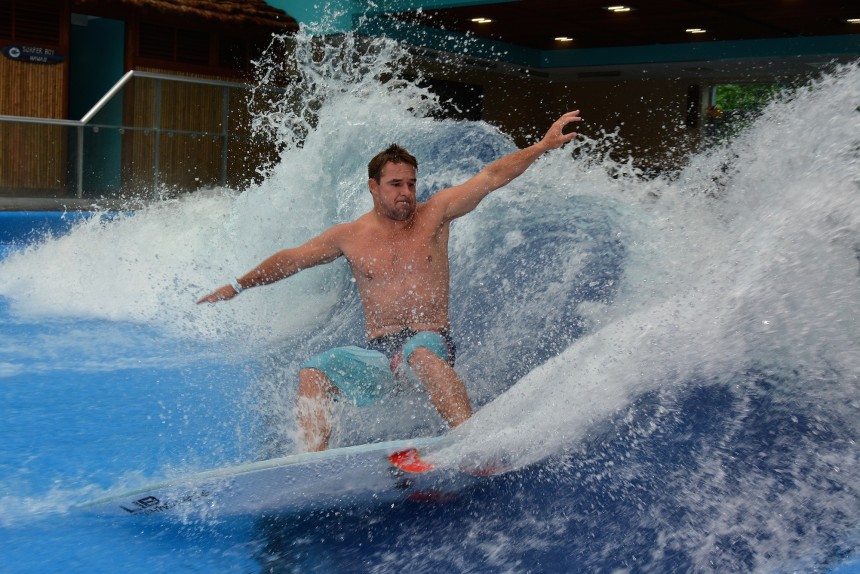
American Wave Machines have also embarked upon that quest for the holiest of Holy Grail when it comes to artificial waves: those which move through a body of water like an ocean wave – a wave that surfers cannot only ride up and down but along the face. Two surf parks in Russia and New Jersey will soon deploy the company’s latest PerfectSwell wave technology.
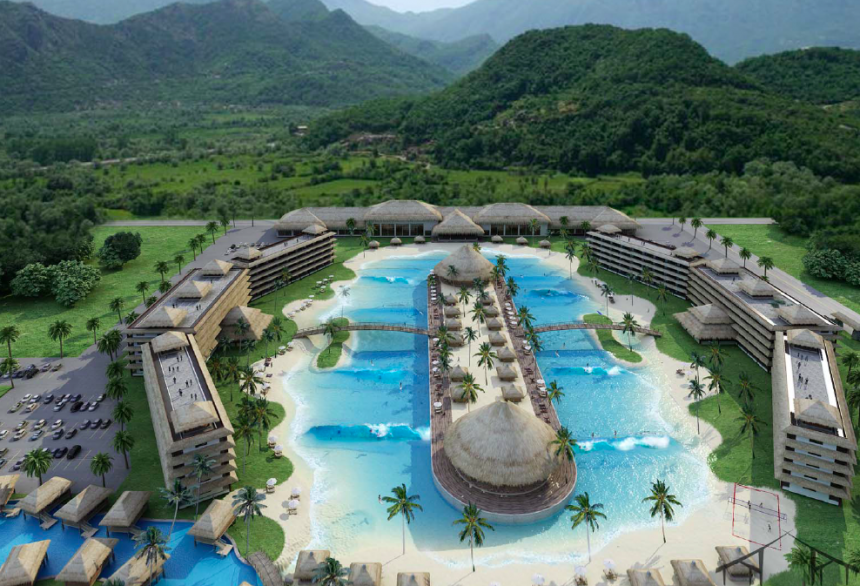
To our level of understanding, unlike other man-made surface waves, which utilize water displacement systems, American Wave Machines’ PerfectSwell is a patented air-powered system designed to replicate how waves are indeed generated in the ocean, by the frictional drag of wind over the water’s surface. As in nature, this is then coupled with the ocean/ pool floor. PerfectSwell is said to be able to adjust the size, shape and wave pattern on a large scale. The wave pool in Sochi, Russia that will utilize this technology is said to be 61m long x 49m wide and will be able to generate waves between 2-6ft.
Murphys Waves
The Scottish company has completed over 200 projects worldwide ranging from their pneumatic sheet wave technology through to their highly revered Point Break Surf System, which mimics the physics of an ocean wave. With respect to active, present-day commercial wave pools utlising the kind of wave technology that best replicates an ocean wave, they are the current market leaders. Murphys Waves are the people behind Typhoon Lagoon in Orlando, The Mandalay Bay in Las Vegas, Siam Park in the Canary Islands and the aforementioned Wadi Adventure park in the United Arab Emirates. The jewel in the crown at Wadi Adventure is capable of producing small rolling waves for beginners through to 10ft waves breaking left or right (there are actually 6 different settings) every 70 seconds. It’s the largest commercial wave-generating machine in the world at present.
Jim Stuart, the Managing Sales Director at Murphys Waves, also says the company is further developing their Point Break Surf System to deliver a barreling wave in excess of 13ft for a new project in Malaysia set to open towards the end of 2015.
Wavegarden
Enter the main contender for the crown of best man-made wave: a group of Spaniards who have been trialing their technology since 2005 in a valley amidst farmlands inland of San Sebastian. They unveiled to the world (a few years later) a clip of the most perfect little peeling barrel that left so many, including myself, completely stunned. Their Wavegarden was/is arguably more economical than anything previously conceived as rather than lay vast amounts of concrete in the construction process they opted for tarping on dirt. Not only that, they have managed to produce the world’s longest artificial wave.
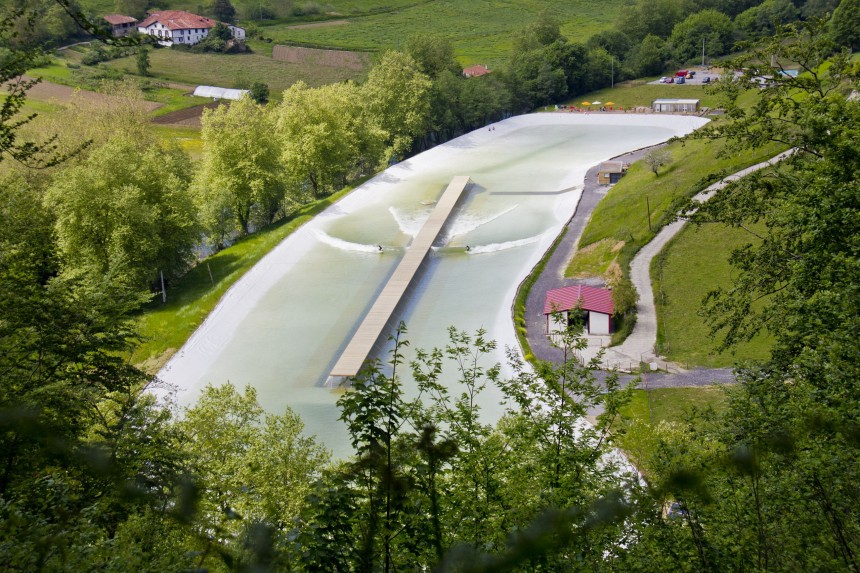
A hydrofoil runs underneath a pier that bisects the lagoon. The winged foils push water over a contoured bottom to create waves that break either side of that pier. 4ft waves peel for some 200+ metres giving surfers a chance to work their wonders for close to 20 seconds. The good news doesn’t stop there though. The nature in which the wave is created means it can hold its form and power over any distance you choose, the only limit is the length of the lagoon and the depth of the developer’s pockets. Furthermore, the facility in Spain is only a prototype. A larger scale version is presently under construction in Snowdonia in Wales that will deliver waves over 6ft.
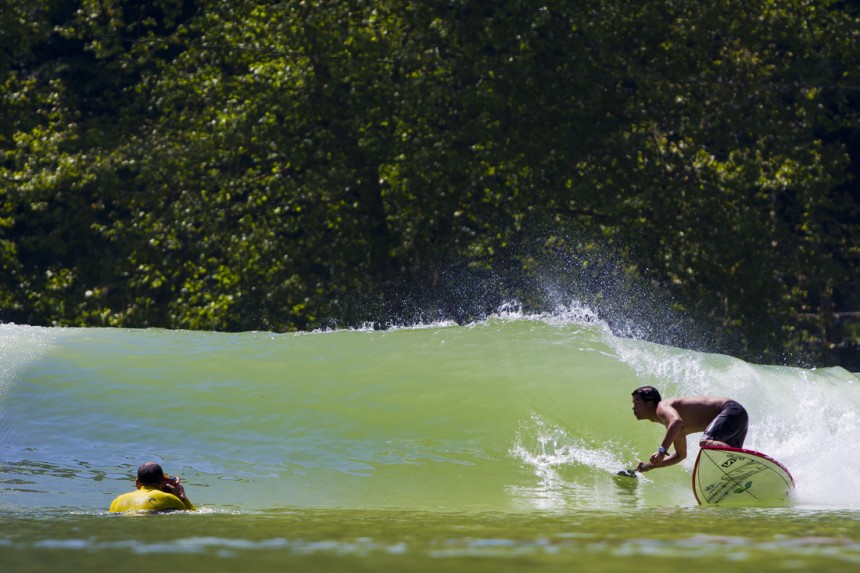
Set to open sometime after Easter next year, Surf Snowdonia will showcase Wavegarden’s latest version of their technology. Andrew Ross, the Founder and Executive Chairman of the Wave Park Group, who hold exclusive rights to the development and operation of Wavegarden surf parks in Australia, enlightened us on what we can expect to see.
“The wave generator, drive system and symmetry of the lagoon are the same however the version we have in Spain is a demonstration centre. It is only 250m long by 45m wide. The full-scale version, which will be delivered in Wales, will be 300m long by 115m wide. The latest version of our technology incorporates the peak wave, which runs adjacent to the pier but we will also have an intermediate size wave which will be immediately adjacent to and parallel to the peak wave. So essentially the broken wave energy emanating from the peak wave will be reformed to an intermediate wave.
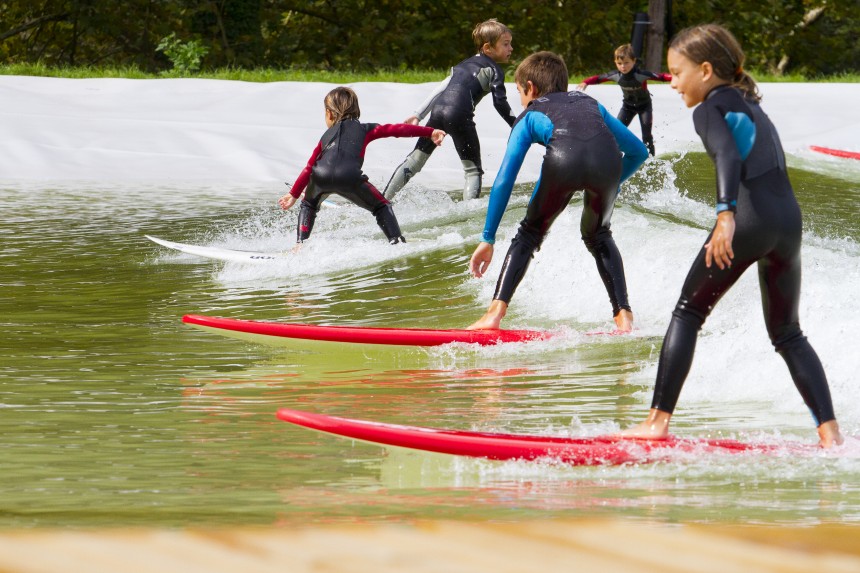
“The peak wave will be close to 2m high and the intermediate wave will be 1.2m high and as the wavefoil travels down the lagoon and stops at the end of the pier, that wave energy is then reshaped into a beginners wave which will be about 0.9m high. It will be very much like a Honolulu Kings and Queens spilling whitewater wave which will run for about 55m to the shore. Once the lagoon settles the wave foil will then proceed back up the pool in the opposite direction generating waves to the other end of the lagoon. “So you can effectively surf the wave forehand one way and backhand in the opposing direction or alternatively you can paddle around the other side of the pier and surf the wave on your forehand again. “I was at the facility in Spain a few months ago and had 125 waves in a row. The next day I could hardly move.” To answer your next question, yes, there are plans to open a Wavegarden facility here in Australia and possibly New Zealand. “We have a number of sites around Australia which are currently being assessed and that we are conducting feasibility studies on. “We have also spoken with Napier City Council about a proposed Wavegarden there but at this stage our focus is very much on Australia.”
Webber Wave Pools
The contenders who are yet to ‘break ground’ in terms of developing a full scale version of their technologies are Webber Wave Pools and the Kelly Slater Wave Company. Greg Webber’s vision may be one step closer to reality however, with potential support from Australian entrepreneur David Baird to develop a site on the Sunshine Coast not far from Australia Zoo. Noosa-based David Baird is the spokesperson for Waterplay Pty Ltd, a privately-owned specialist consultancy with experience in projects such as Sunway Lagoon in Malaysia and Wadi Adventure Park in the United Arab Emirates.
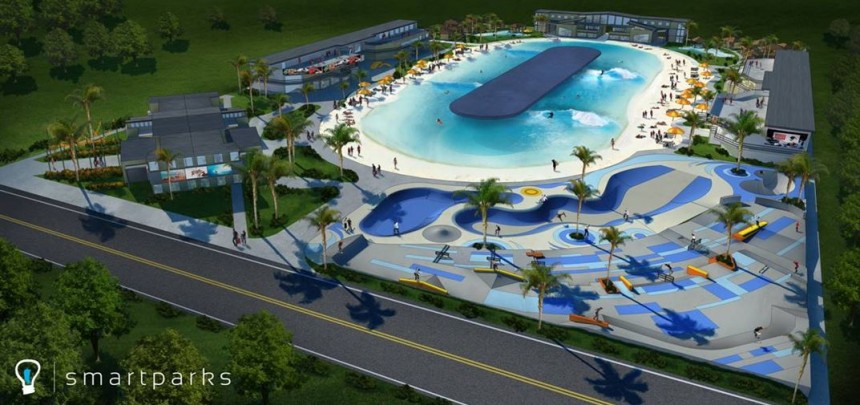
More recently it was announced Waterplay had lodged a planning application for a $90 million water park, which included a 120-room hotel, restaurants, holiday village, canoeing experience, waterslides and a 160m x 90m looped linear Webber Wave Pool that can create 5ft waves with the view to possibly building another 200m x 100m that can deliver waves 6ft+. Mr Baird said that the proposed development would be delivered in two stages over three years, with the water and surf pool built first, opening to the public sometime in 2016, followed by the tourism accommodation and other facilities. That said, no contract has yet been finalised, to our knowledge.
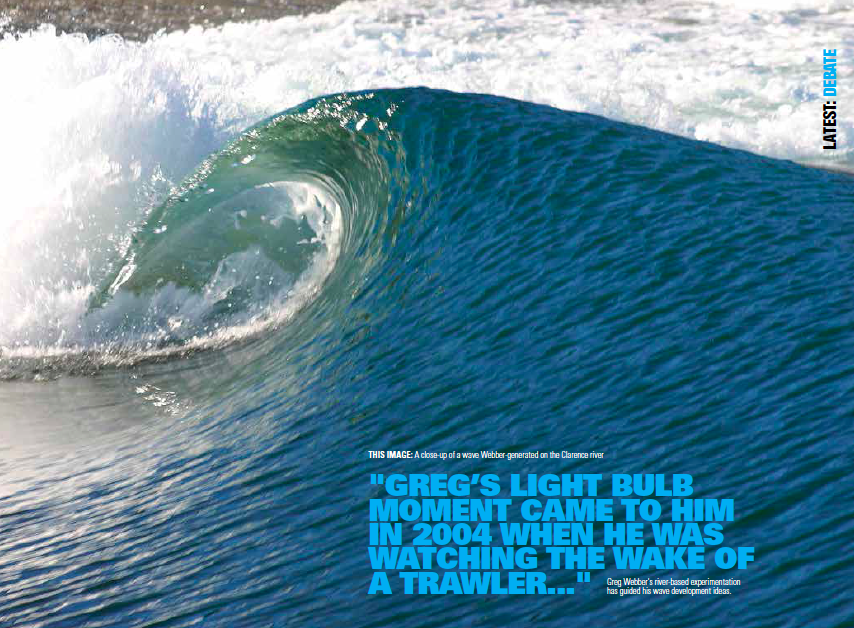
In terms of the technology employed by Webber Wave Pools, Greg’s light bulb moment came to him in 2004 when he was watching the wake of a trawler boat breaking along the banks of the Clarence River (Yamba) against the incoming tide. What he saw was enough to divert his attention from building surfboards to designing wave pools. He’s since built successful scale models at the Australian Maritime College in Tasmania and conducted numerous field tests in the Clarence River using his patented technology. His initial design was a circular ring-shaped wave pool where waves were generated on the outer edge, peeling towards a central island. Greg has retained the same wave making technology but has since moved to a looped-linear design on the basis it requires less land to be developed (as per the planning application at Glenview on the Sunshine Coast).
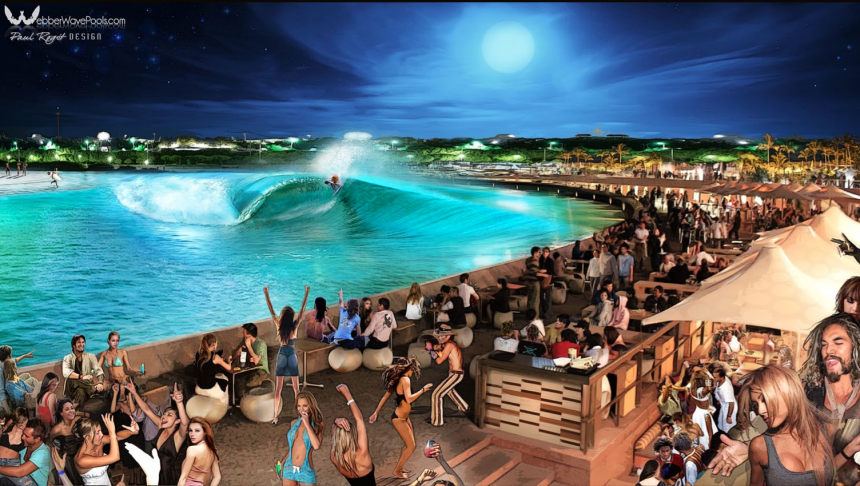
If we understand it correctly, the main focus of Greg’s technology relates to the angle of the wave generated, its profile and the way in which it barrels. Furthermore, rather than pushing water forward to create a wave that barrels higher up the wave towards the lip, Greg’s technology is designed to push water downwards to create the wave, delivering a distinct trough at the bottom of the wave face. The way in which the wave barrels apparently sees it draw water from the bottom allowing surfers to tube ride a dredging bowl. Apparently the wave size and shape can also be altered whilst a surfer is on the wave to reflect the nuances of waves in nature, the purpose being to test the ability of the surfer to read the wave and adapt accordingly.
Kelly Slater Wave Company
Another party entering the fray that cannot be ignored due to its figurehead being the greatest surfer of all time, Kelly Slater, is the wave company of the same name. The most influential surfer of a generation, and arguably ever, has the profile to potentially catapult the popularity of surf parks into the stratosphere. However to date, little has been said or is known about KSWC’s technology.
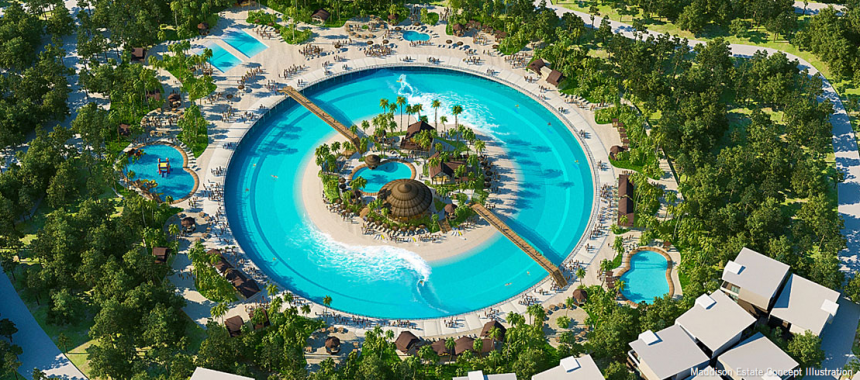
Computer renderings suggest the plan is to construct huge circular pools where surfers would ride an endless wave generated by a hydrofoil. KSWC’s design had similarities to that of Webber Wave Pools… After the initial turbulence, the water settled so to speak and Webber pursued a design that creates two waves simultaneously and Kelly focused on the one. Various news reports suggest the Gold Coast may be the first to experience Slater’s vision in the not-too-distant future with reportedly a housing conglomerate to install one of his circular wave pools in a billion-dollar development.
MAKING WAVES IS BIG BUSINESS
It is clearly evident wave pools have become big business. The greater surf industry has been flat-lining for quite some time. Wave Parks are viewed as a means to revive the surf industry and see it return to its halcyon days. Encouraging more people to become actual surfers rather than just boardie-wearing wannabes is what many believe will see the waves of gold rolling in once more. Just think of all the gear you bought from rashies through to your first surfboard when you started surfing. As such there’s now even a Surf Park Summit held annually to “accelerate surfing outside the ocean.”
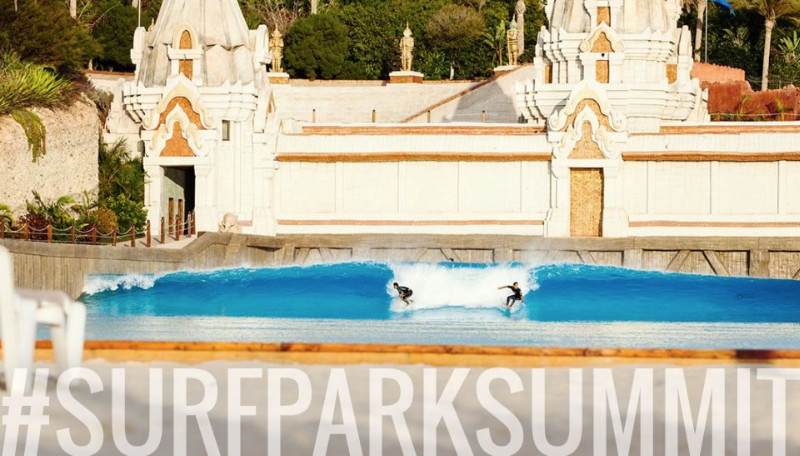
Prime Time Viewing
Many involved or associated with the wave park industry have expressed their desire to see surfing evolve into an Olympic sport and even screened on prime time television. Without the continual advancement of wave pool technology that could not even be considered due to the fickle nature of… well nature. How can you schedule a televised event in prime time if you can’t predict what the surf is doing? The predictable, and even now programmable, nature of man-made waves means contests could be scheduled at the desired time, day or night.
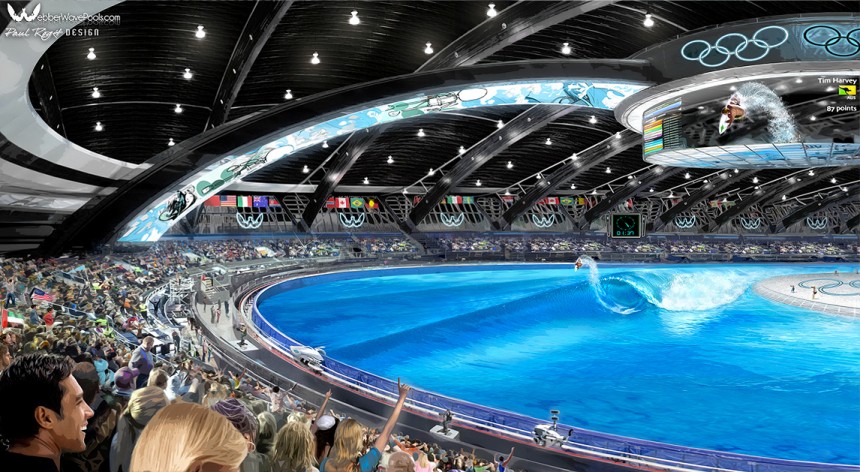
Prime time viewing also means big mainstream sponsors and the truckloads of cash that potentially follow. In turn this would raise the profile of elite surfers and the subsequent prize money available, attracting more and more athletes to the sport.
LATEST: DEBATE
The ability to “manufacture” identical waves would also deliver a level playing field in which surfers could showcase their skill and be judged purely on their performance on that “same” wave without the subjectivity that inevitably comes into play when evaluating surfers on different waves out in the ocean. Surfers could be solely assessed on their ability to ride the said given wave without the interference of Mother Nature’s ever-changing moods, but then again… isn’t that what surfing is about? Man, woman or child up against the unpredictable ravages of Mother Nature and somehow coming out the other side triumphant, or at least alive? On the flip side, many sports are now played on artificial surfaces or in controlled environments nowadays. We have football played in indoor arenas, hockey played on artificial turf, cycling in velodromes (hang on those guys shave their legs so that probably doesn’t count as a good example).
Another appeal of wave parks is the potential for them to become high performance training venues for competitive surfers, much the same way as a swimmer uses a pool. To use an analogy, swimmers need never be concerned with turning up for training to find the pool is not full of water. Surfers will have waves on tap – reliable, consistent and always working.
For the original article or to download a PDF of the print edition visit Smorgasboarder.com

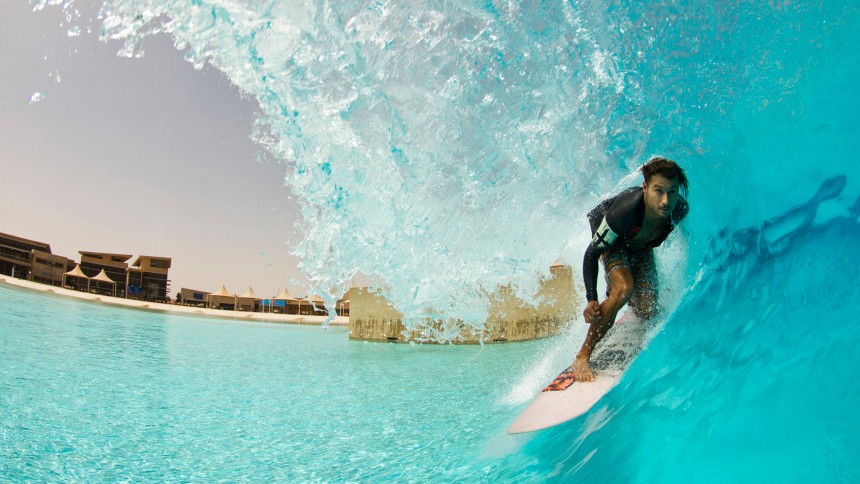
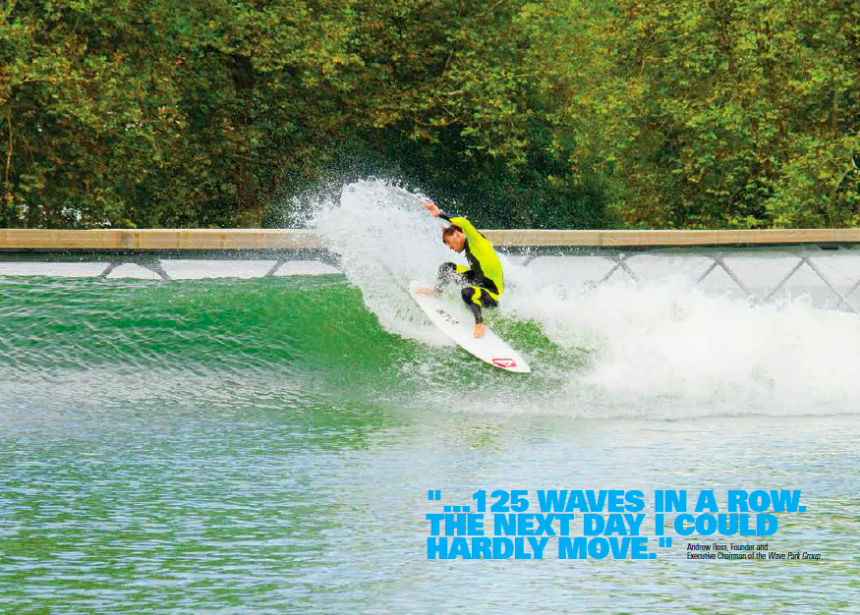
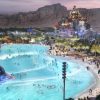
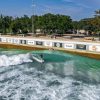
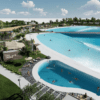
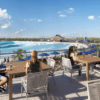
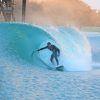
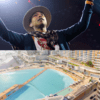
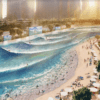
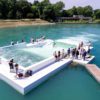
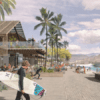
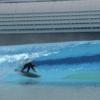

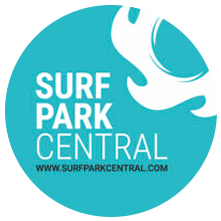


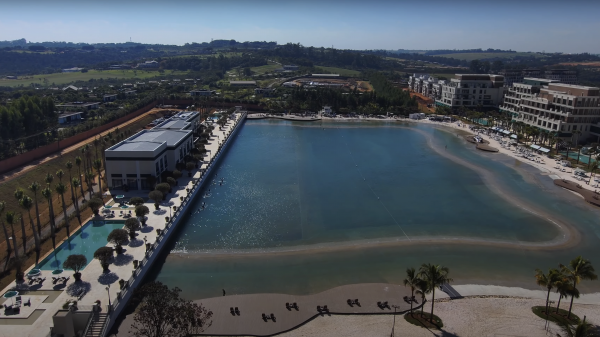

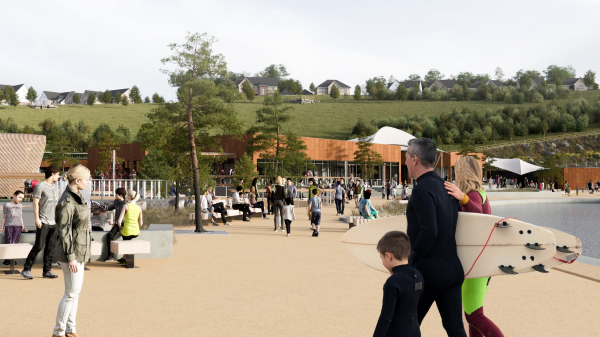

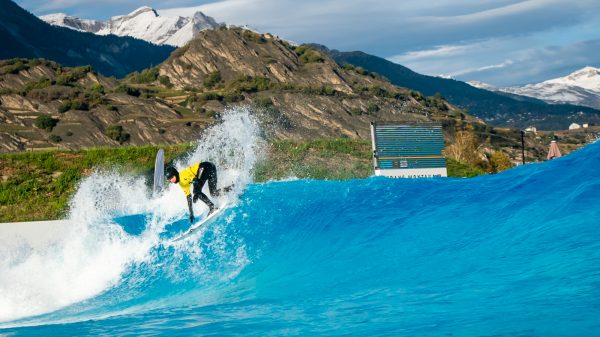
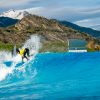
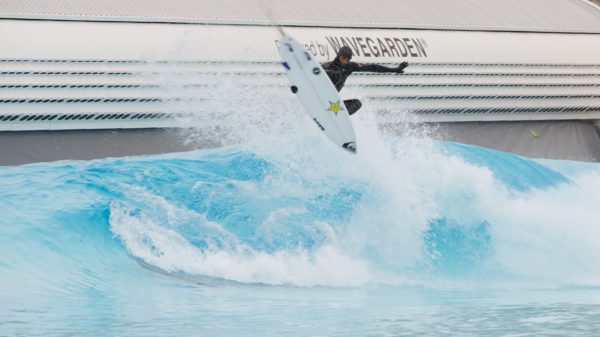
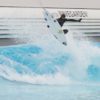
Pingback: 5 things to know about Austin’s newest water park | Visit TX